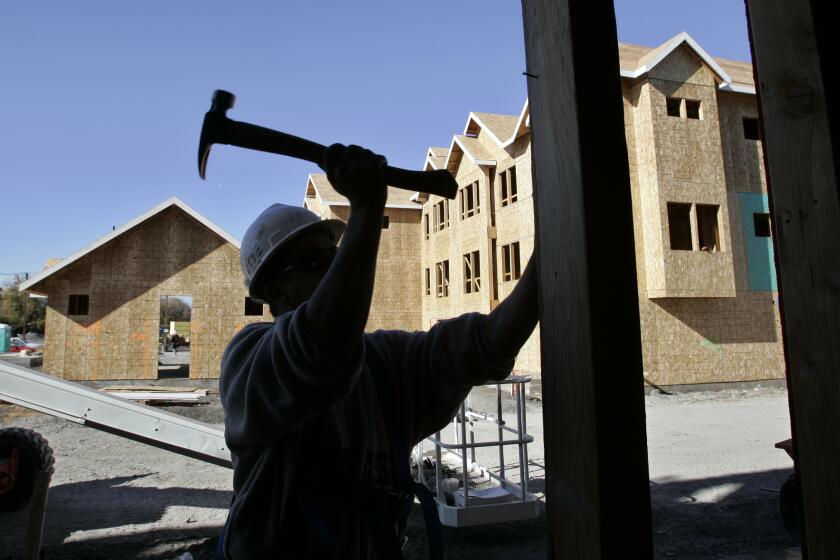N.Y. Apartment Building Cut Down to Size After Developer’s Mistake : Zoning: The top 12 stories are being torn off because of protests by a community group that noticed the high-rise structure exceeded legal limits.
“Bang! Wham! Crash!” The racket that shatters the silence of the reading room in the East 96th Street public library is the sound of the Manhattan skyline falling--a bit of it, at least.
Next door, a 7,000-pound, hammer-wielding robot is pounding away at the top floor of an unoccupied apartment house that rises 31 stories, 12 more than zoning laws allow.
When it is finished, some months from now, the robot will have reduced 108 E. 96th St. to 18 stories, turned its upper floors to rubble and struck a blow for the sanctity of zoning.
“Finally, we’re going to see a little more sky,” exulted Genie Rice, head of the community group that waged a five-year battle to cut the tower down to size. “This shows that New Yorkers really care about their zoning.”
It also shows that Rice knows how to read a zoning map; she was the one who noticed that the high-rise building was going up in a low-rise zone.
In other times and places the builder of the too-tall tower might have gotten off with a fine or a deal. But many New Yorkers are sick of high-rise development and its attendant congestion, noise and shadow--which explains why $1 million is being spent to destroy apartments in a city with a housing shortage.
The demolition project, although not technically exotic, is apparently unprecedented. Taller buildings have been torn down, but never has so tall a building--let alone a brand-new one--virtually been cut in two.
The battle over 108 E. 96th dates to the summer of 1986, when Rice complained to the city that the red brick building going up on a hillside east of Park Avenue was inside a special Park Avenue zoning district, which limits building heights to 210 feet.
The developer, Laurence Ginsberg, said he based his plans on a city zoning map that showed the site outside the special district.
The map, it turned out, was in error--a number had fallen off the master en route to the printer. The city told Ginsberg to stop, but he appealed the order and kept building--reversing normal practice and finishing the disputed upper floors first.
Eventually, various courts and boards ruled that the developer should have known the building site was inside the district.
Ginsberg offered to build housing for the elderly if he could keep the top 12 floors. To some, such a deal seemed sensible; the extra 12 stories didn’t make much difference in a busy, built-up neighborhood. But Rice’s group was adamant: No deal.
“We had to draw the line somewhere,” she said. For years, zoning laws were waived and building heights soared in return for “public amenities” that often amounted to little more than a barren plaza.
The Supreme Court denied Ginsberg’s appeal in 1988, but litigation continued until 1991, when he agreed to remove the 12 stories. It has taken another two years for demolition to begin, largely because of a general concern that it be done safely.
The building’s upper half is surrounded by a cage of scaffolding and netting to catch any falling debris. Inside, what used to be the roof is being slowly destroyed by the robot, a Brokk 250. This machine is no R2-D2; although it is remotely controlled, it has four wheels and acts more like a tractor than a humanoid.
After a floor’s walls and windows have been removed, the robot attacks the slab around the edges, eventually backing itself into a corner. Then workers using a hoist and a ramp lower the robot to the floor below, where the process is repeated.
Debris is dropped to the street through a metal chute, creating the noise that shakes the library. The water tower and elevator machinery have been lowered to the 20th floor, which will become the roof. Altogether, the demolition is expected to cost $1 million.
Although Ginsberg has kept his silence lately, he is said to be bitterly disappointed. Demolition, he said last year, “is a painful way to correct a mistake on a zoning map.”
For some, the fall of 108 E. 96th seems anticlimactic. “We were going to close the street for a celebration, we were going to do a hundred things,” said Judy Fresco, a neighbor. “Now, it’s like an engagement that goes on for years--it no longer seems important.”
More to Read
Sign up for Essential California
The most important California stories and recommendations in your inbox every morning.
You may occasionally receive promotional content from the Los Angeles Times.





